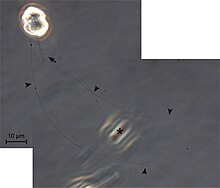Peridiniella danica
| Peridiniella danica | ||||||||||||
|---|---|---|---|---|---|---|---|---|---|---|---|---|

Peridiniella danica |
||||||||||||
| Systematics | ||||||||||||
|
||||||||||||
| Scientific name | ||||||||||||
| Peridiniella danica | ||||||||||||
| ( Paulsen ) Okolodkov & Dodge, 1995 |
The unicellular dinoflagellate Peridiniella danica is a representative of the marine plankton . The cells are armored with a thin theca, free-living and heterotrophic. The species was first described in 1907 by Ove Paulsen as Glenodinium danicum and redefined by Y. Okolodkov and J. Dodge in 1995 and classified in the genus Peridiniella .
features
Peridiniella danica cells correspond to slightly flattened ellipsoids dorso-ventrally, with large cells compressed and small cells stretched. The size of the cells is given differently by different authors and averages around 20 µm. The size also changes with the nutritional status, because starving cells lose size.
The cingulum lies in the middle, is screwed off by a belt width and ends in a curve in the sulcus . The sulcus is extended as a narrow furrow towards the apex , where it is expanded by a characteristic pore. The cells can be clearly asymmetrical by dividing along a diagonal plane.
distribution
Peridiniella danica can be found in the plankton of the oceans worldwide . Find reports are available from the northern and equatorial Atlantic, the Greenland Sea, Barents Sea, Skagerrak as well as the tropical Pacific and off New Zealand.
Way of life
Chloroplasts have not been observed so far, which is why it can be assumed that the species is purely heterotrophic. The cells swim at a speed of up to 200 µm / s and can also prey on mobile flagellates such as Cryptophyceae and Coccolithophorida . The prey is fixed with a catching filament and then phagocytosed .
Individual evidence
- ^ Paulsen, O. (1907). The Peridiniales of the Danish waters . Medd. Komm. Fi Havundersog., Series Plankton 1: 1 - 26.
- ↑ a b c Okolodkov, Yuri B. and Dodge, John D. (1995) Redescription of the planktonic dinoflagellate Peridiniella danica (Paulsen) comb. nov. and its distribution in the NE Atlantic , European Journal of Phycology 30: 4, 299 - 306. ( full text )
- ↑ a b Okolodkov, Yuri B. (1999). Differentiation of phototrophic and heterotrophic dinoflagellates (Dinophyceae) by epifluorescence microscopy in the northern Greenland Sea . Russian Academy of Sciences, Botanical Journal 84, No. 4: 53-61
- ↑ Meunier, A. (1910). Microplancton de la mers de Barents et de Kara . In: Duc d'Orleans, Campag ~ Ie Arctique de 1907. Charles Bulens, Bruxelles.
- ^ Waite, Maya M. and Lindahl, Odd (2006). Bloom and decline of the toxic flagellate Chattonella marina in a Swedish fjord . Marine Ecology Progress Series, vol. 326: 77 - 83. ( full text ; PDF; 521 kB)
- ↑ Hasle, GR (1960). Phytoplankton and ciliate species from the tropical Pacific . Det Norske Vidensk.-Akad, Oslo. L Mat.-Naturv, class, 2: 1-50, pl. 1-8.
- ↑ MacKenzie, L. (1991). Toxic and noxious phytoplankton in Big Glory Bay, Stewart Island, New Zealand . J. Appl. Phycol. 3: 19 - 34. ( abstract and full text )
- ^ Neumann, A. (2008). Feeding mechanism of the dinoflagellate Peridiniella danica . Master thesis, University of Rostock. ( Full text ; PDF; 7.8 MB)
